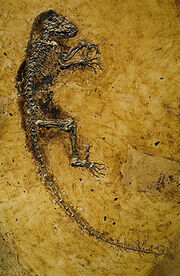
Primary slab of the holotype and only known specimen
Darwinius is a genus of primitive primate from the Eocene of Germany. It is often lauded as the "missing link" between early and advanced primates.
Description[]
Darwinius is known from only one skeleton (nicknamed "Ida"[1]), missing only its left rear leg. A juvenile female, it measures 58 centimeters in length from head to tail, and resembles a modern lemur in body shape. Along with the skeleton, impressions of fur have been preserved, as well as the animal's stomach contents of fruit and leaves.
Classification[]
The single species, Darwinius masillae, was placed in the Notharctidae family of adapiform primates by its original discoverers. This is not a classification shared by all scientists, however.[2]
History[]
The Darwinius specimen was originally discovered in 1983 at the Messel shale pit near Frankfurt, Germany as a slab and counter slab, which were at some point separated. The counter slab was embellished with fake parts and delivered to a Wyoming museum in 1991. It was soon revealed that the specimen was a composite.[3]
The primary slab remained in Germany in the hands of a private collector, and after twenty years it was sold to a fossil dealer.[4] In 2006, Norwegian paleontologist Jørn Hurum met with the dealer, who showed him photographs of the skeleton and stated that the asking price for the specimen was $1 million. Realizing the importance of the fossil, Hurum persuaded the Natural History Museum of Oslo to provide funding to buy the specimen, after he proved that it was not a fake.[5] The specimen was then studied in secret for two years, and was officially described in 2009 accompanied by extensive media hype.[6]
Paleobiology[]
Reconstructions of the specimen's teeth reveal that it was not yet fully grown and ate leaves and seeds. Its right wrist was also recovering from a recent fracture, which may have contributed to the animal's death in some form.[7]
References[]
- ↑ Christine McGourty (19 May 2009). "Science & Environment; Scientists hail stunning fossil". BBC News. Retrieved 2009-05-20.
- ↑ Ann Gibbons (19 May 2009). ""Revolutionary" Fossil Fails to Dazzle Paleontologists -- Gibbons 2009 (519): 1 -- ScienceNOW". ScienceNOW Daily News. American Association for the Advancement of Science.
- ↑ Franzen, J.L. (1994), in Anthropoid Origins (eds Fleagle, J. F. & Kay, R. F.)pp 99-122 (Plenum, New York)
- ↑ Fossil Ida: extraordinary find is 'missing link' in human evolution, a 19 May 2009 article from The Guardian
- ↑ James Randerson (19 May 2009). "Fossil Ida: A profile of palaeontologist Jørn Hurum | Science | guardian.co.uk". London: The Guardian.
- ↑ Franzen, J. L.; Gingerich, P. D.; Habersetzer, J.; Hurum, J. H.; Von Koenigswald, W.; Smith, B. H. (2009). "Complete primate skeleton from the Middle Eocene of Messel in Germany: morphology and paleobiology" (PDF). In J., Hawks. PLoS ONE 4 (5): e5723. Bibcode:2009PLoSO...4.5723F. doi:10.1371/journal.pone.0005723. PMC 2683573. PMID 19492084.
- ↑ ""MISSING LINK" FOUND: New Fossil Links Humans, Lemurs?". National Geographic. May 19, 2009.